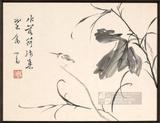宋文同墨竹 軸
推薦分享
資源連結
連結到原始資料 (您即將開啟新視窗離開本站)後設資料
- 資料識別:
- 故畫000835N000000000
- 資料類型:
- 繪畫
- 著作者:
- 文同
- 主題與關鍵字:
- 竹
- 日期:
- TIME STAMP:26-4月 -05
- 格式:
- 本幅 131.6x105.4公分
- 關聯:
- 故宮書畫錄(卷五),第三冊,頁61-62&故宮書畫圖錄,第一冊,頁265-266&文同(西元一0一八-一0七九)字與可,四川梓潼人。善畫竹,他的好友蘇軾為他的竹子寫過許多首題畫詩。 墨竹是文人畫中重要的題材之一,而文同正是北宋墨竹的代言人。畫中的一枝墨竹,竹葉和竹枝從左上方垂下,再往右方微印而上,寓屈伏中隱有勁拔的生機。此畫不但是客觀觀察與筆墨技巧的呈現,也是士大夫人格與節操的隱喻。畫葉的墨色有濃淡的對比,據米芾說也是自文同始。 &Wen T'ung was a native of Szechwan who excelled at painting bamboo. His friend Su Shih inscribed many poems on his paintings of bamboo. Ink bamboo is an important subject in scholar painting and Wen T'ung is a representative example from the Northern Sung. Here, a stalk of bamboo done in ink bends down from the upper left and then curve back up to the right, giving movement and grace to the form. Not only has the artist skillfully handled the ink and observed the actual appearance of bamboo, but he also created a metaphor for the grace and resilience of the Chinese scholar. The use of rich contrast in ink tones for bamboo leaves is said by Mi Fu (1051-1107) to have started with Wen T'ung.
- 管理權:
- 國立故宮博物院
授權聯絡窗口
- 國立故宮博物院圖像授權、出版授權、影音資料授權-申請流程說明
http://www.npm.gov.tw/zh-TW/Article.aspx?sNo=03003061






